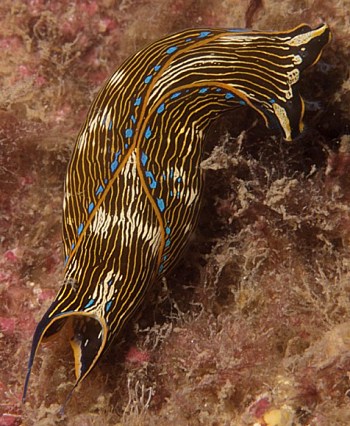
Navanax inermis
(Cooper, 1863)
Order: CEPHALASPIDEA
Family: Aglajidae
DISTRIBUTION
From Monterey Bay, California to Laguna Manuela, Mexico. Also throughout the Gulf of Mexico.
PHOTO
Big Fisherman Cove, Wrigley Institute, Catalina Island, Los Angeles County, California, USA. 26-27 May 2001, 5-8 m depth. Photo: Daniel Geiger
Navanax inermis is probably the largest aglajid growing to at least 22cm in length. It is dark brown to black with a pattern of cream to yellow longitudinal lines, sometimes broken, and sometimes replaed by a close pattern of spots. The parapodia have an orange line along the edge, and an inner line of bright blue spots or dashes. The pallial lobes at the back of the posterior shield are relatively large and taper to a point.
In nature, Navanax inermis feeds on other sea slugs - such as bubble shells and sometimes nudibranchs. On rocky shores it tends to feed on nudibranchs such as Hermissenda crassicornis, Polycera atra and Dirona picta, while on sheltered muddy or sandy bottoms it feeds on bubble shells such as Haminoea virescens and Bulla gouldiana.
Anatomically Navanax shows no difference from the related genus Aglaja and I suggested many years ago that they should be synonymised. However the name Navanax persists in the popular literature. Species of aglajids like all opisthobranchs are hermaphrodite. In this family the penis is on the right side of the head while the genital opening is on the right side at the rear of the body. To mate, the partner acting as the male has to approach the "female" from behind. Often chains of three or more mating animals will form with those in the middle acting as male and female simultaneously. SEE Reggie Northern Californian Underwater Photographic Society website
Dr Rhanor Gillette's lab has a movie showing Navanax inermis feeding on an aeolid. This shows that like the aglajid genera Melanochlamys and Chelidonura, it feeds by using the buccal bulb as a suction pump. See also Bill Wright's message #16251 reporting Navanax eating Aplysia californica.
References:
• Cimino, G., Crispino, A., Sodano, G. & Spinella, A (1987) Alchilpiridine ed alchilbenzeni da Opistobranchi Bullomorfi: composti relazionati ai feromoni di allarme del Navanax inermis. Atti del XVII Convegno Nazionale della Divisione de Chimica Organica, Societa Chimica Italiana.
• Fenical, W., Sleeper, H.L., Paul, V.J., Stallard, M.O. & Sun, H.H. (1979) Defensive chemistry of Navanax and related opisthobranch molluscs. Pure and Applied Chemistry, 51: 1865-1874.
• Leonard, J.L. & Lukowiak, K .(1984) An ethogram of the sea slug, Navanax inermis (Gastropoda, Opisthobranchia). Z Tierpsychol, 65: 327-345.
• Leonard, J.L. & Lukowiak, K. (1985) Courtship, copulation, and sperm trading in the sea slug, Navanax inermis (Opisthobranchia: Cephalaspidea). Can. J. Zool., 63: 2719-2729.
•Paine, R.T. (1963) Food Recognition and Predation on Opisthobranchs by Navanax inermis. The Veliger, 6(1): 1-9.
•Paine, R.T. (1965) Natural History, Limiting Factors and Energetics of the opisthobranch Navanax inermis. Ecology, 46(5): 603-619.
• Rudman, W.B. (1974) A comparison of Chelidonura, Navanax and Aglaja with other genera of the Aglajidae (Opisthobranchia, Gastropoda). Zoological Journal of the Linnean Society, 54(3): 185-212.
• Sleeper, H.L., Paul, V.J. & Fenical, W. (1980) Alarm pheromones from the marine opisthobranch Navanax inermis. J. Chem. Ecol., 6(1): 57-70.
• Sleeper, H.L. & Fenical, W. (1977) Navenones A-C: Trail breaking alarm pheromones from the marine opisthobranch Navanax inermis. Journal of the American Chemical Society, 99: 2367-2368.
• Spinella, A., Alvarez, L.A., Crispino, A., Marin, A., Villani, G. & Cimino, G. (1992) Chemical signals in some Cephalaspidean molluscs. Abstracts, 11th International Malacological Congress, Siena 1992: 289-290.
Rudman, W.B., 2003 (April 29) Navanax inermis (Cooper, 1863). [In] Sea Slug Forum. Australian Museum, Sydney. Available from http://www.seaslugforum.net/factsheet/navainer
Related messages
-
Re: Parasites and Navanax inermis
From: Ernie Hartt, September 25, 2007 -
Re: Parasites and Navanax inermis
From: Kevin Lee, August 17, 2007 -
More on Navanax inermis
From: Kevin Lee, August 16, 2007 -
Parasites and Navanax inermis
From: Kevin Lee, August 16, 2007 -
Re: Navanax inermis mucus cocoon
From: Ernest Hartt, August 15, 2007 -
Might this be Navanax inermis?
From: Ken Tucker, August 14, 2007 -
Swimming Navanax from central California
From: Ron Eby, August 6, 2007 -
Navanax inermis laying eggs
From: Bruce Wight, July 28, 2007 -
Navanax inermis mucus cocoon
From: Phil Garner, May 23, 2007 -
Trail following in Navanax inermis
From: Ernest Hartt, August 29, 2006 -
Navanax - Aplysia interactions
From: William G. Wright, April 7, 2006 -
Navanax eating Aplysia
From: Brad Bartczak, September 17, 2005 -
Is this Navanax?
From: Peter McGuinness, December 28, 2004 -
Re: Strange lunch for Navanax
From: Ernie Hartt, December 18, 2003 -
Strange lunch for Navanax
From: Bruce Wight, November 15, 2003 -
Navanax - yellow secretions
From: Tammy, October 13, 2003 -
Navanax inermis from Long Beach, California
From: Crystal, April 30, 2003 -
Re: Navanax larval culture
From: Bill Rudman, March 21, 2002 -
Larval development of Navanax
From: I.M. Loeza & A.M. Ortiz, March 19, 2002 -
More photos of Navanax inermis
From: Daniel Geiger, July 29, 2001 -
Some photos of Navanax inermis
From: Daniel Geiger, July 27, 2001 -
Predators of Navanax inermis
From: Shannon, March 10, 2001 -
Cannibalism in Navanax inermis
From: Ernie Hartt, February 19, 2001 -
Navanax diet
From: Vincent A. Parsick III, January 27, 2001 -
Navanax inermis
From: Erwin Koehler, October 3, 1998
